Hon maguro, or bluefin tuna, is arguably the most important fish at the sushi bar. It’s where three of the most iconic sushi cuts come from: otoro, toro, and chutoro.
This post takes a deep dive into the world of bluefin. You’ll learn the differences between the various cuts, where they’re from, and how they taste. You’ll also learn about some of the rarer cuts.
Links to online retailers of bluefin and toro are also included, and I may earn commission on purchases through these links.
What is Hon Maguro?
Hon maguro (本マグロ) is bluefin tuna. There are three species: Atlantic bluefin, Pacific bluefin, and southern bluefin. But in the sushi world, hon maguro generally refers to Pacific bluefin. Regardless, all bluefin is highly prized as sushi and sashimi.
Bluefin is the largest of the tunas and can live up to 40 years. It’s also warm-blooded, which is rare for fish.
Several iconic types of sushi come from this fish. This includes otoro, toro, chutoro, and akami. Some of these are rare and expensive.
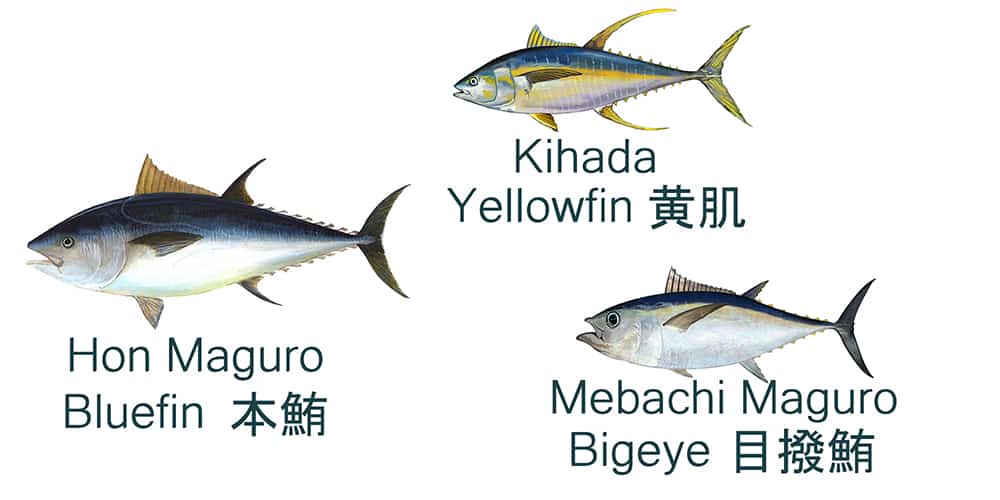
What Does Hon Maguro Taste Like?
There are different cuts of hon maguro. And each has its own texture and flavor. But in general, it’s meaty, fatty, and has lots of umami. It’s also often slightly sweet.
One reason bluefin tuna sushi is so popular is that it’s not fishy. At least, it shouldn’t be.
Fattier pieces of bluefin can have a buttery or oily texture. And the fat lines can sometimes be tough or chewy, though not to the level of beef fat.
On the other end of the spectrum, leaner cuts of bluefin like akami tend to be firmer with a bit of acidity.
Next up: the main cuts of hon maguro and their flavor profiles are explored.
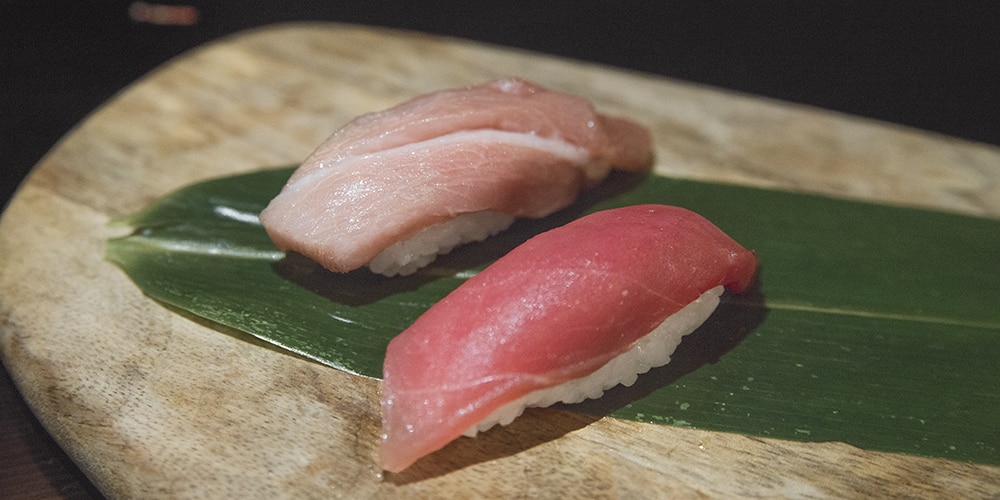
Hon Maguro Sushi Cuts
If you’re a sushi fan, you’ve seen some of these names before.
These are some of the most sought-after pieces of sushi. Some of them can be pretty expensive. And others are so rare you’ll have to have good friends behind the sushi bar to experience them.
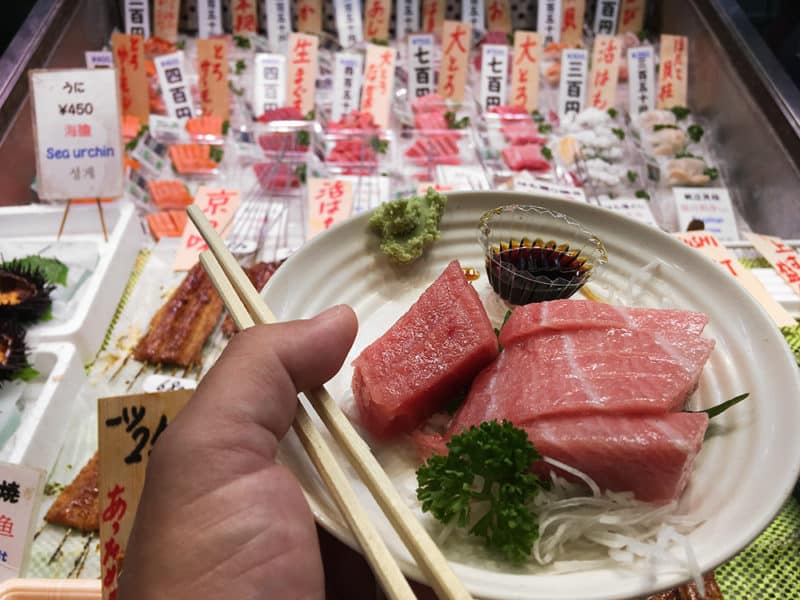
Otoro Sushi and Sashimi
The fattiest part of the bluefin tuna is called otoro (大トロ). Many people think this is the best part of the maguro, and it’s usually the most expensive.
Only a little otoro is found on bluefin. And it’s always along the belly.
There are two main types of otoro. And they taste different.
At the base of the belly is the jabara (蛇腹) otoro. Jabara is the fattiest type of toro. It’s buttery and rich. But the sinew can also be tough, so it’s typically rested to make it softer.
Sometimes too much fat is a bad thing. So it’s not unheard of for chefs to sear otoro before making it into nigiri or sashimi.
Jabara means bellows because the fat lines resemble bellows on an accordion or old-school camera.
The other type of otoro is shimofuri (霜降). It has amazing marbling like high-end wagyu. It’s not as fatty as the bellows belly otoro, either. But it still melts in your mouth. And it’s also smooth and rich.
Bluefin produce a relatively small amount of shimofuri otoro.

Fresh Bluefin Tuna Belly (Otoro)
from: Riviera Seafood Club
Online Retailers of Otoro
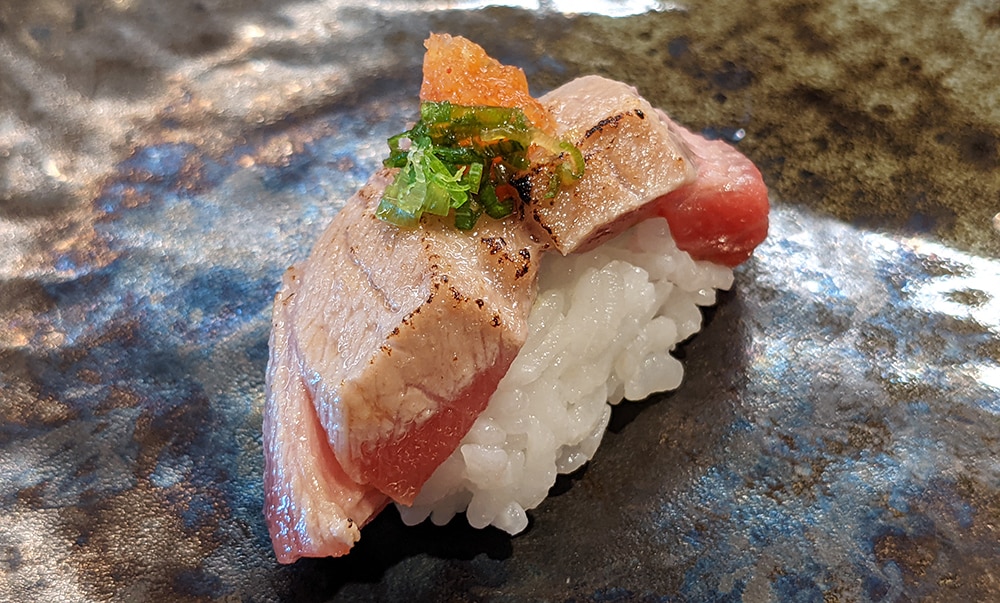
Toro Sushi and Sashimi
Toro (トロ) is a broad term for fatty tuna. Otoro and chutoro are both types of toro.
When toro is on a restaurant menu, it’s usually because it’s not fatty enough to be called otoro. But it’s not as lean as chutoro.
Either way, toro is extremely popular at the sushi bar. It’s typically prepared as nigiri or sashimi. But it can also be found minced in negitoro or in creative hand rolls.
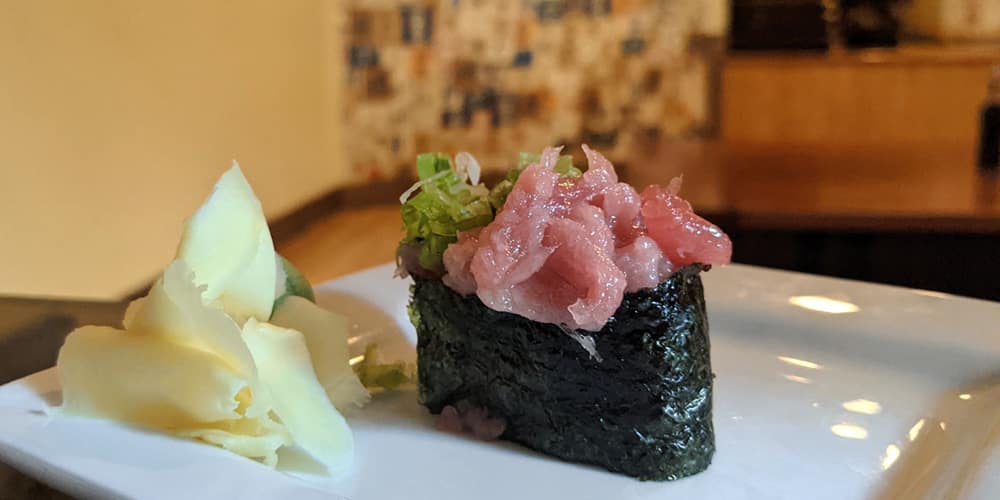
Chutoro Sushi and Sashimi
Chutoro (中トロ) is medium-fatty tuna. Many will argue it’s the best cut from the bluefin. Whether or not you agree, it’s highly prized for nigiri and sashimi.
In general, chutoro is semi-sweet, rich in umami, and smooth. It has a great texture, and unlike otoro, it’s never oily.
Chutoro comes from the back and the belly sides of the fish. In both cases, it’s usually on the sides, close to the skin.

Fresh Bluefin Tuna (Chu-Toro) 4 lbs
from: Riviera Seafood Club
Online Retailers of Chutoro
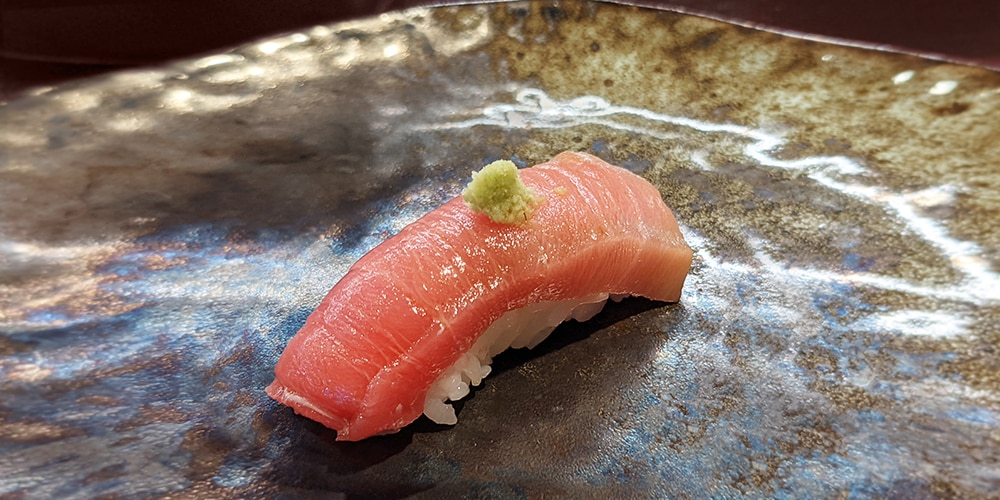
Akami Sushi and Sashimi
Akami (赤身) is lean red meat. It’s popular in nigiri, sashimi, and rolls like tekka maki. And lower quality akami is sometimes used in spicy tuna.
Akami has a mellow flavor, some umami, and a firm texture. It can also taste a little sour on the finish.
Bluefin is abundant in akami. But other species like bigeye tuna and yellowfin only have akami.
Both the back and the belly of maguro have akami. But in both cases, it’s located in the center of the fish, near the spine.

Fresh Bluefin Tuna (Akami) 4 lbs
from: Riviera Seafood Club
Online Retailers of Akami
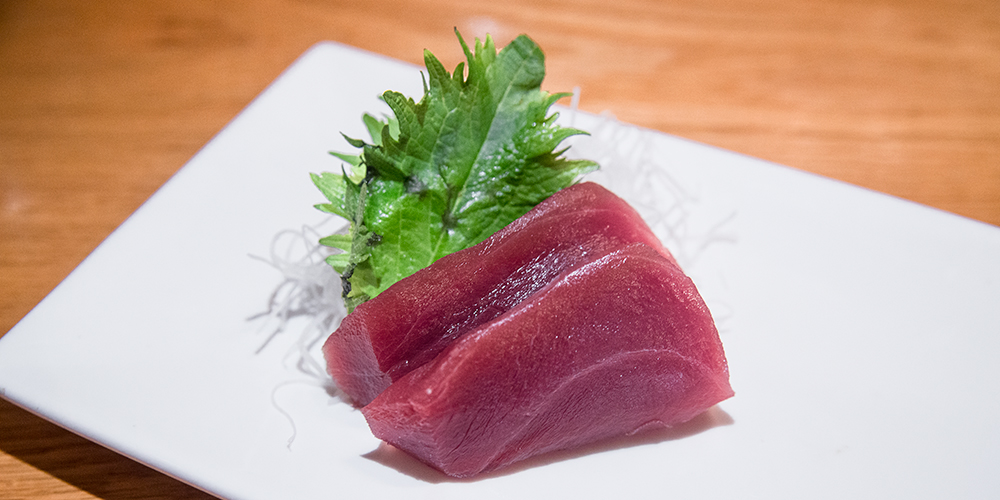
Wakaremi Sushi and Sashimi
Wakaremi (分かれ身) is adjacent to the hire, or fin. It’s found under the back fins and above the anal fin. And because of this, it has a lot of fat. It’s considered more premium than chutoro, though slightly less fatty.
But this is a very rare sushi item. Even mature hon maguro have only one or two slabs (saku) of wakaremi.
Many sushi chefs in America aren’t familiar with the term wakaremi. And in my 15+ years working in Japanese restaurants, I’ve only had it a few times – usually seared. It’s often eaten by chefs or served in omakase.
Bluefin Tuna Sushi 24X18 Poster
Love toro? I created this poster for tuna addicts and sushi chefs. It’s the ultimate tribute to hon maguro sushi.
You can find it in my store* and on Etsy.
*US customers only
Hon Maguro Sections
Different sections of bluefin have specific names and yield different types of meat. In general, hon maguro is divided into three sections: the upper (kami), middle (naka), and lower (shimo).
And these three sections are further divided by the back (se) and the belly (hara). So overall, there are six primary parts of the bluefin used for sushi and sashimi.
You won’t find any of the six listed on the menu, but experienced chefs will know the differences. And there are a few other parts of maguro worth knowing about too. I’ll cover those, as well.
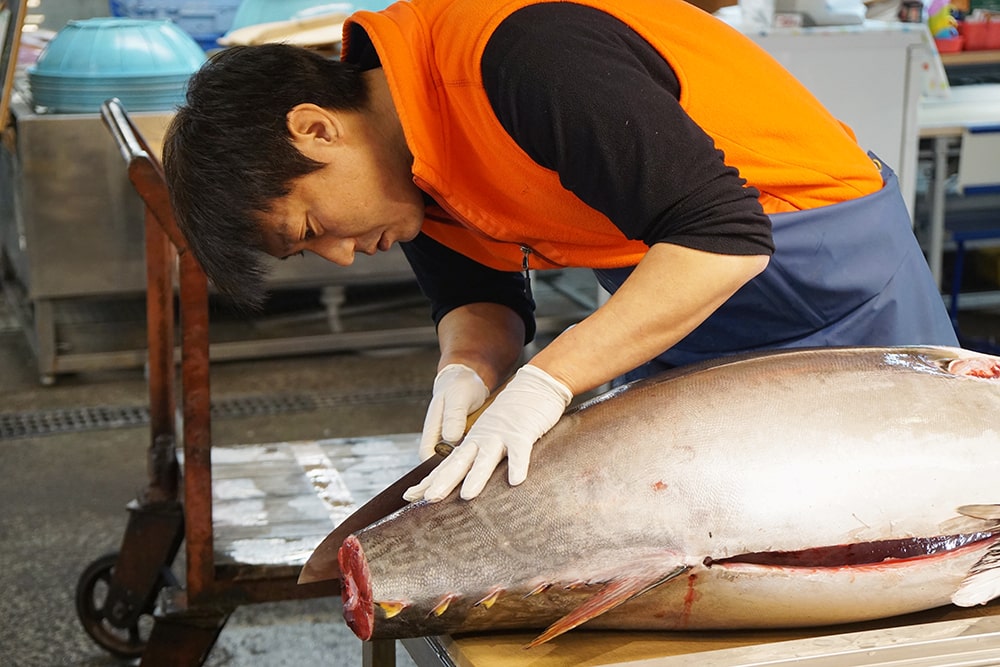
Kami
The kami (上) is the upper part of the maguro, meaning it’s closer to the head. It’s the fattiest part of the fish.
Harakami
The belly section is called harakami (腹かみ). It’s the location of all the kami otoro.
The lowest part has the jabara otoro or bellows belly.
Jabara is extremely fatty. It can also be oily and with hard sinew. Resting this otoro will soften the fat and makes nigiri and sashimi that melt in the mouth.
Higher up the belly is a small amount of shimofuri otoro or marbled flesh. Fattiness is between chutoro and jabara. Only a tiny amount is available, and it’s delicious.
Harakami chutoro is also scarce. It’s above the otoro on the side of the tuna. It’s highly-prized chutoro and moderately fatty.
Finally, there is a tiny amount of akami from this section. It’s above the belly bone and next to the spine. It is tasty but can have a mild bloody smell and elevated acidity.
Sekami
The back portion of the kami is called sekami (背かみ). This section has a lot of akami, a fair amount of chutoro, and a little wakaremi.
Sekami chutoro is less fatty than harakami. And it also has the tendency to split when made into nigiri. So it’s typically served as sashimi, in tekka maki, or negitoro.
Sekami is abundant in akami. And its quality is high. It lacks a bloody aroma, has good umami, and has soft acidity.
At the base of the dorsal fin is a strip of wakaremi. It’s highly prized and very rare. It has a smooth taste that’s in between chutoro and akami.
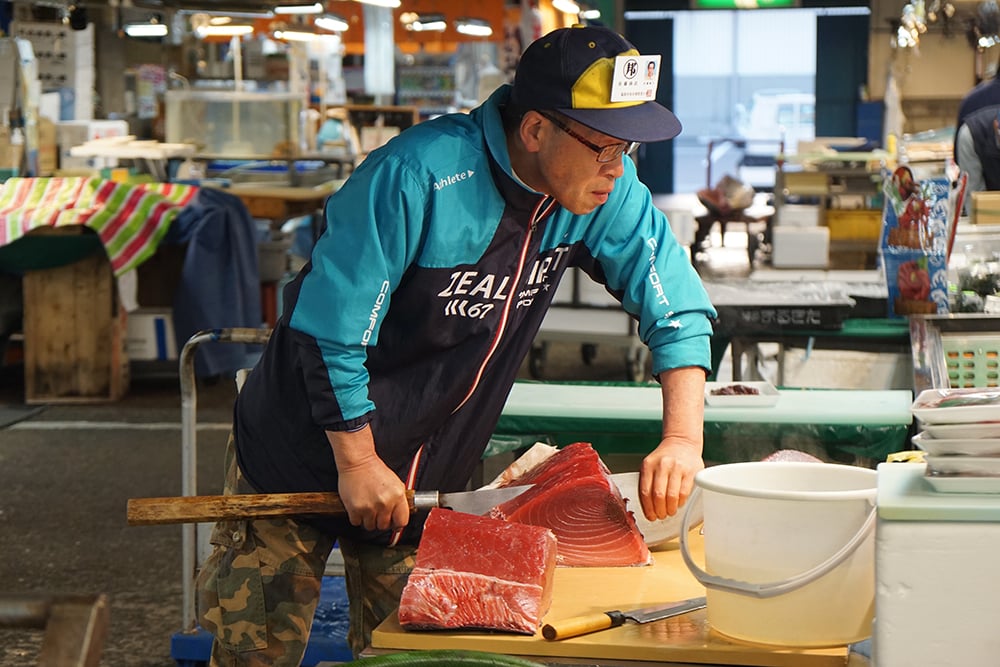
Naka
The middle section of a maguro is called naka (中). It has a lighter flavor and less sinew than the kami section. Again, it’s divided into two parts.
Haranaka
Haranaka (腹なか) is the middle belly section. Like harakami, it has both types of otoro plus chutoro and akami.
Jabara otoro here has a redder color and less fat. But it still makes excellent nigiri and sashimi.
The shimofuri otoro is only slightly fattier than chutoro. Some chefs will call this toro. And only a tiny amount of this marbled otoro is available.
However, a lot of chutoro comes from the haranaka. It’s located all along the side of the fish.
Finally, the haranaka has a lot of akami. It has a mild flavor but isn’t as good as akami from the back.
Senaka
Senaka (背なか) is the middle back section. It has chutoro, akami, and a tiny amount of wakaremi.
Less chutoro is available on the senaka than the haranaka. It’s located on the side and near the back. The chutoro from the side makes excellent nigiri and sashimi. But closer to the back, it often splits and has tough sinew. This part is better for maki.
Akami is abundant in the senaka section. It makes good sushi and sashimi. But it’s not all the same. Closer to the lower section (seshimo), it’s tougher and leaner.
Shimo
Shimo (下) is the lower section of the maguro. It’s close to the tail, so it has less fat and more muscle.
Harashimo
The lower belly section is called harashimo (腹しも). It’s mostly akami with some chutoro, and a sliver of wakaremi.
The chutoro is on the sides. It has a slightly rough texture compared to other chutoro.
Akami from the harashimo has a great flavor with lots of umami.
Wakaremi is available above the anal fin. It has lots of fat.
Seshimo
The seshimo (背しも) section is the leanest and lightest-flavored part of the back. It’s mostly akami. But there’s some chutoro on the side and a bit of wakaremi under the fins.
Chutoro from this section can have a rough texture, similar to harashimo chutoro.
And the akami is lean but with good umami.
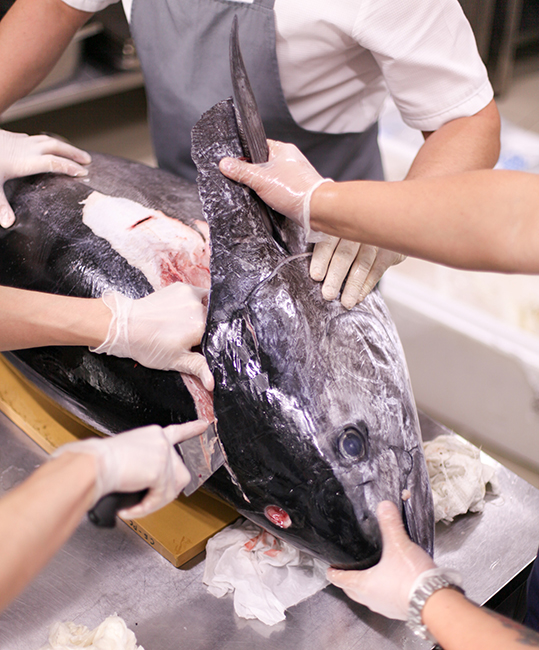
Other Parts of the Bluefin
The sections of maguro listed above aren’t the only parts that get eaten. Below are some of the more obscure areas of the bluefin.
Kamatoro
Kamatoro (鎌とろ) is the “otoro of all otoro” because it’s so fatty. But it also has hard sinew and can smell and taste fishy. It’s usually cooked and rarely served as sushi.
Hohoniku
Hohoniku (ほほ肉) is the cheak meat. It’s very fatty and also rare. Sometimes it’s found in restaurants. And it will often be seared. But usually, fishmongers eat this part.
Noten
Noten (脳天) is the crown of the head. This area of the tuna is also sometimes called toniku (頭肉), or head meat. Noten is prized and is like a very soft, creamy-textured chutoro. Typically, fish brokers eat this part of the maguro.
Medama – Tuna Eye
Tuna eyes or medama (目玉) are a popular cooked item. They can sometimes be found at izakaya. Typically, only the inside of the eye is eaten. It has a mild flavor, so it’s often braised or sauteed with other ingredients to add flavor.
O – Tail
Bluefin tail or o (尾) is not a part used for sushi. It’s lean, muscular meat. And it has a tough texture and can be gamey tasting.
O is often grilled. But because it has little fat, it will overcook quickly.
Conclusion
Well, as Gil Faizon might say: that’s a lot of tuna fish.
What are your thoughts on hon maguro sushi and its famous cuts otoro, chutoro, and akami? Is it overrated or worth the hype?
And are you concerned about the sustainability of bluefin tuna?
If you’re a big fan of this fish, be sure to check out my hon maguro stickers, shirts, and posters in my store.
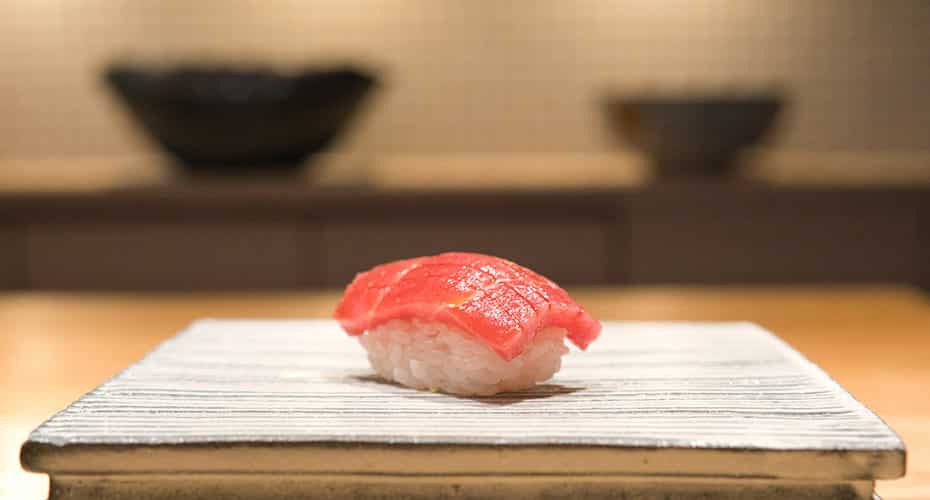

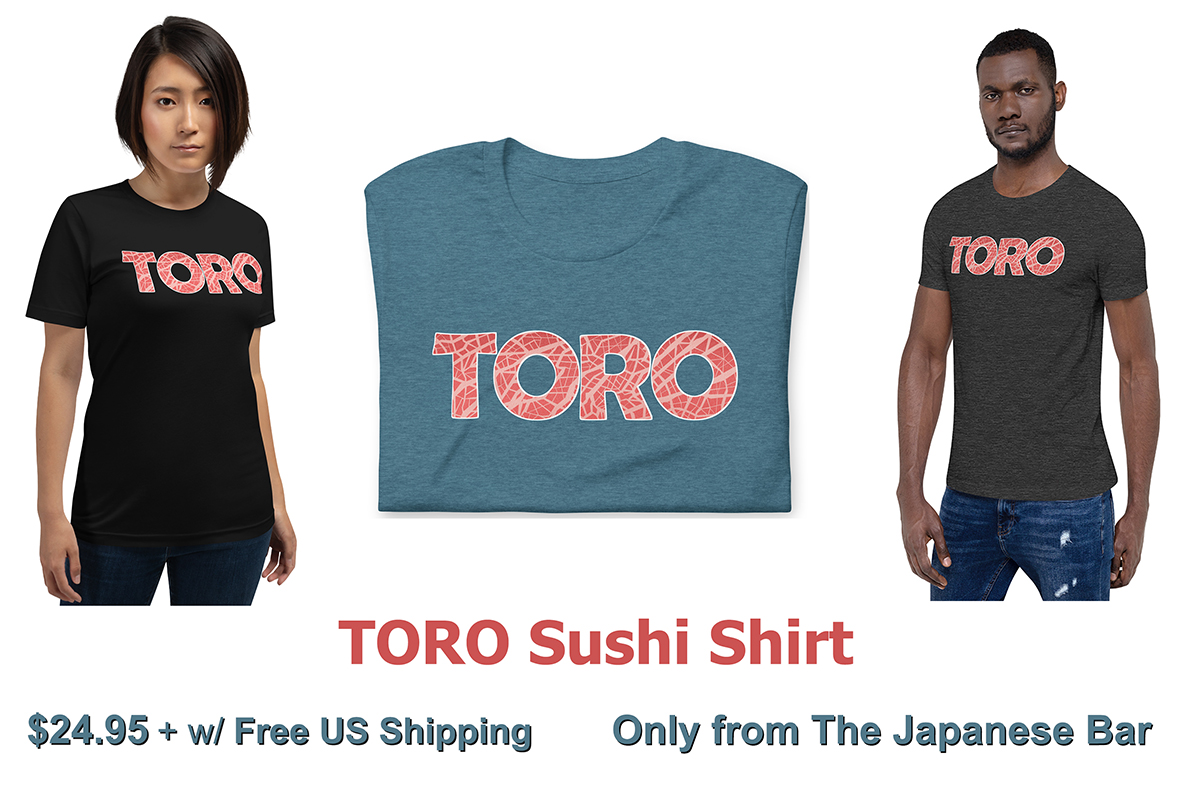
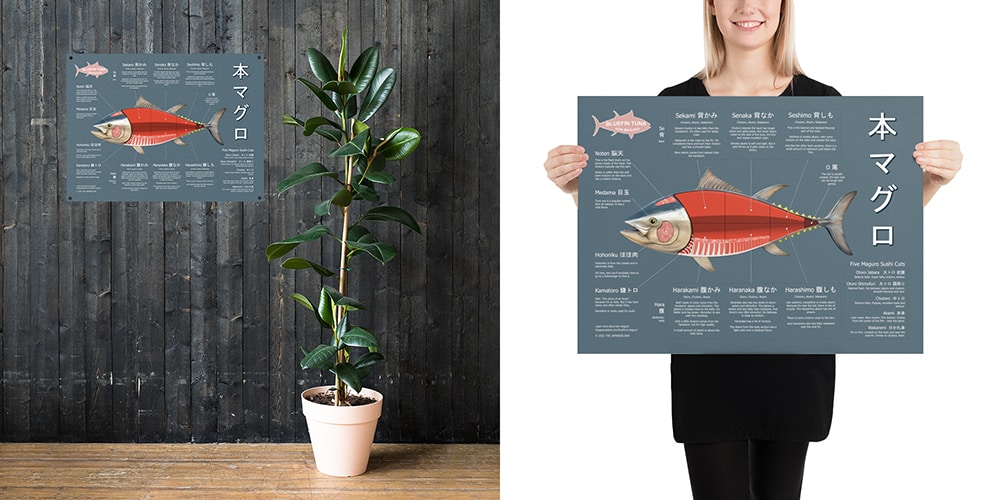
What is your two favorite part – rare and more commonly available?
Hi Norman,
Chutoro is my favorite. After that, it’s marbled otoro.
What about you – what’s your favorite?
Thanks for commenting!
Brad